Computer Hardware: Components, Ports, and Functionality Explained
VerifiedAdded on 2021/08/10
|7
|1149
|162
Homework Assignment
AI Summary
This document offers a comprehensive overview of computer hardware basics, detailing the various components that make up a computer system. It begins by outlining the fundamental parts, including input/output (I/O) devices, the central processing unit (CPU), and different types of memory (RAM, ROM, and hard drives). The notes explain the function of the motherboard, various ports (serial, monitor, parallel, USB, Firewire, PS/2, and Ethernet), and the power supply. Additionally, it describes expansion cards (sound, graphics, and network), storage devices (CD/DVD ROM, floppy drive), and cooling components (fan and heatsink). The document also touches upon the small electronic parts like capacitors, resistors, and transistors and concludes with a discussion of the computer case. Comprehension questions are provided to test understanding of the material.

Notes - Computer Hardware Basics
The Computer
A computer is made up of many parts:
1. Input/Output (I/O) devices – These allow you to send information to the
computer or get information from the computer.
2. Central Processing Unit – CPU or Processor for short. The brain of a
computer. Approximately 1.5 in X 1.5 in. Does all the computation/work for
the computer.
3. Memory – Although memory is technically any form of electronic storage, it
is used most often to identify fast, temporary forms of storage. Accessing the
hard drive for information takes time. When the information is kept in
memory, the CPU can access it much more quickly.
The Computer
A computer is made up of many parts:
1. Input/Output (I/O) devices – These allow you to send information to the
computer or get information from the computer.
2. Central Processing Unit – CPU or Processor for short. The brain of a
computer. Approximately 1.5 in X 1.5 in. Does all the computation/work for
the computer.
3. Memory – Although memory is technically any form of electronic storage, it
is used most often to identify fast, temporary forms of storage. Accessing the
hard drive for information takes time. When the information is kept in
memory, the CPU can access it much more quickly.
Paraphrase This Document
Need a fresh take? Get an instant paraphrase of this document with our AI Paraphraser
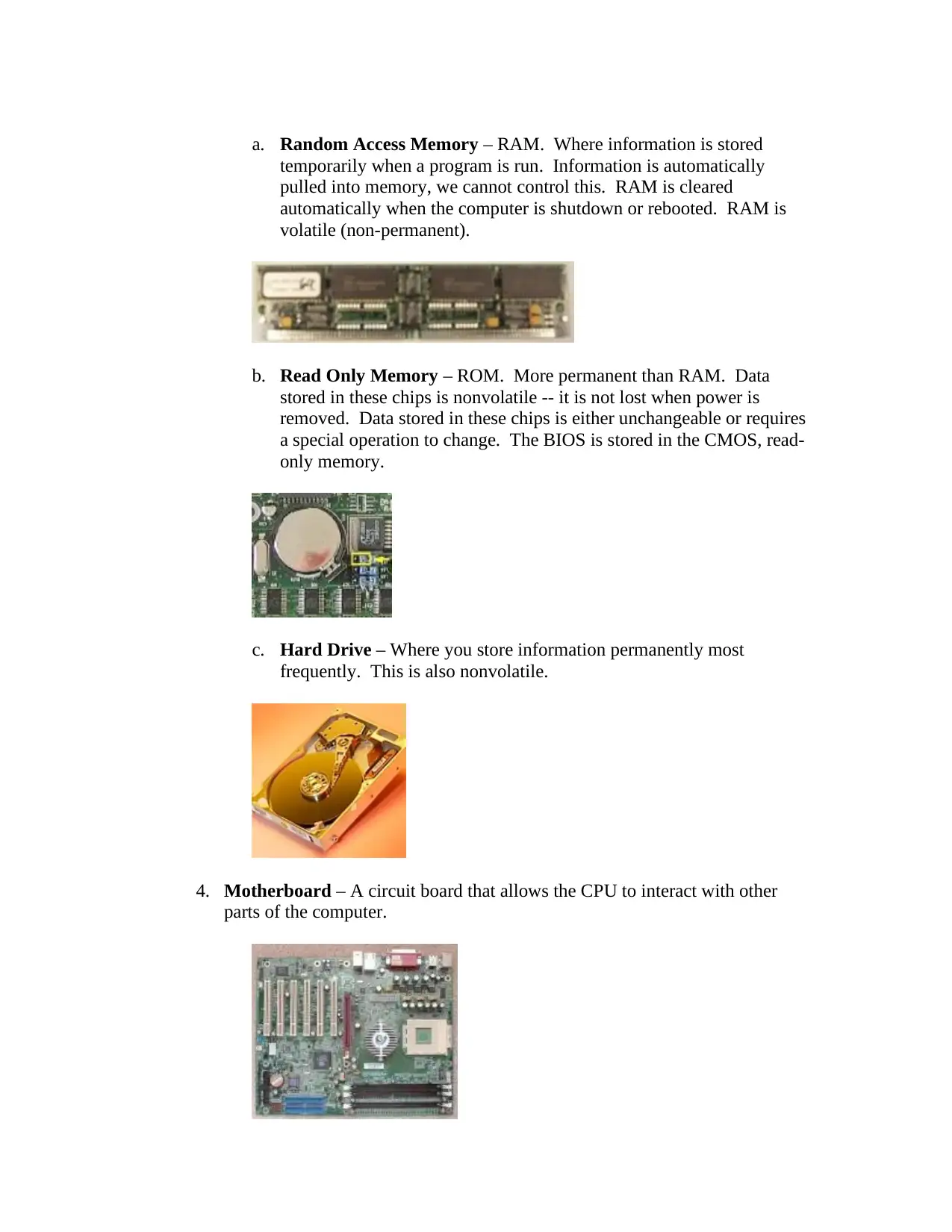
a. Random Access Memory – RAM. Where information is stored
temporarily when a program is run. Information is automatically
pulled into memory, we cannot control this. RAM is cleared
automatically when the computer is shutdown or rebooted. RAM is
volatile (non-permanent).
b. Read Only Memory – ROM. More permanent than RAM. Data
stored in these chips is nonvolatile -- it is not lost when power is
removed. Data stored in these chips is either unchangeable or requires
a special operation to change. The BIOS is stored in the CMOS, read-
only memory.
c. Hard Drive – Where you store information permanently most
frequently. This is also nonvolatile.
4. Motherboard – A circuit board that allows the CPU to interact with other
parts of the computer.
temporarily when a program is run. Information is automatically
pulled into memory, we cannot control this. RAM is cleared
automatically when the computer is shutdown or rebooted. RAM is
volatile (non-permanent).
b. Read Only Memory – ROM. More permanent than RAM. Data
stored in these chips is nonvolatile -- it is not lost when power is
removed. Data stored in these chips is either unchangeable or requires
a special operation to change. The BIOS is stored in the CMOS, read-
only memory.
c. Hard Drive – Where you store information permanently most
frequently. This is also nonvolatile.
4. Motherboard – A circuit board that allows the CPU to interact with other
parts of the computer.
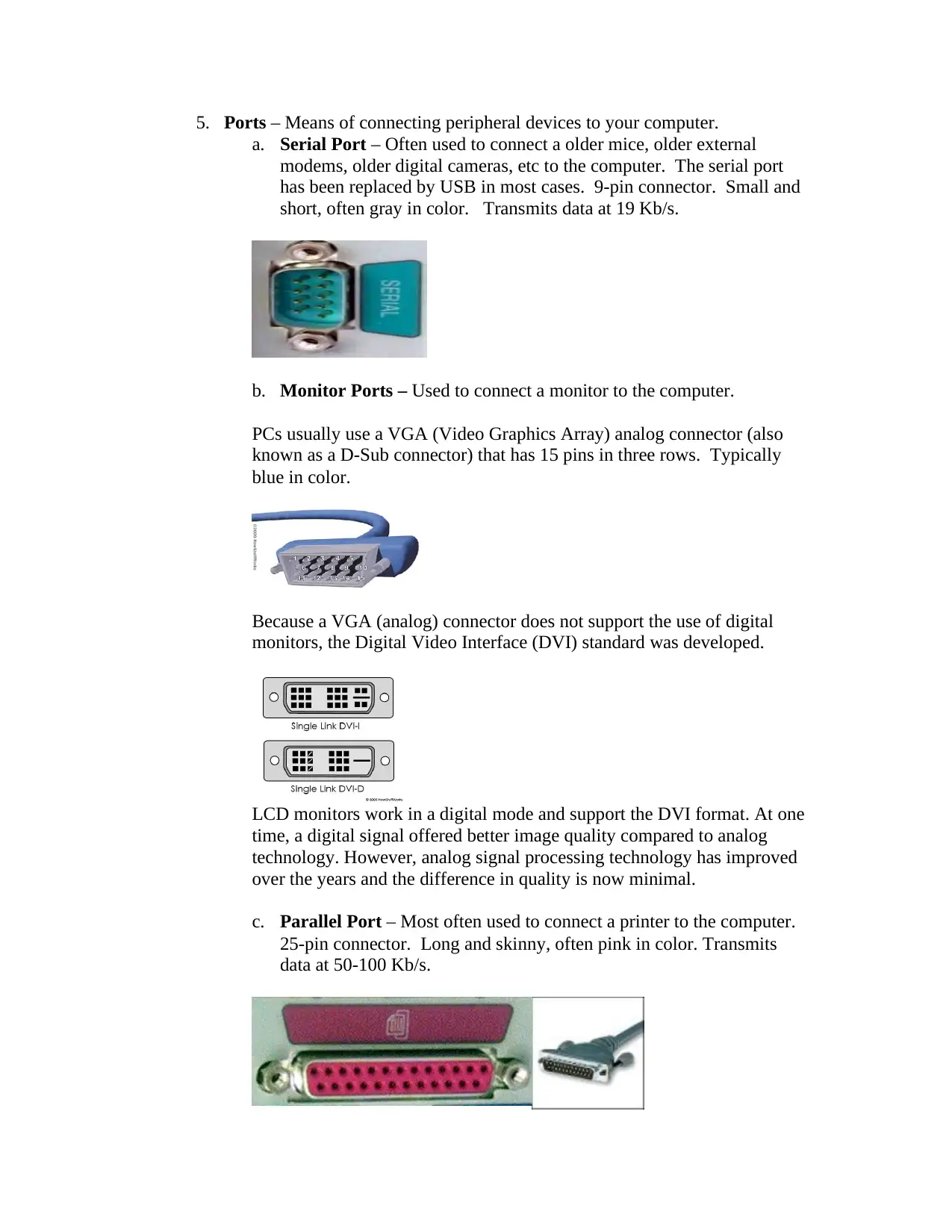
5. Ports – Means of connecting peripheral devices to your computer.
a. Serial Port – Often used to connect a older mice, older external
modems, older digital cameras, etc to the computer. The serial port
has been replaced by USB in most cases. 9-pin connector. Small and
short, often gray in color. Transmits data at 19 Kb/s.
b. Monitor Ports – Used to connect a monitor to the computer.
PCs usually use a VGA (Video Graphics Array) analog connector (also
known as a D-Sub connector) that has 15 pins in three rows. Typically
blue in color.
Because a VGA (analog) connector does not support the use of digital
monitors, the Digital Video Interface (DVI) standard was developed.
LCD monitors work in a digital mode and support the DVI format. At one
time, a digital signal offered better image quality compared to analog
technology. However, analog signal processing technology has improved
over the years and the difference in quality is now minimal.
c. Parallel Port – Most often used to connect a printer to the computer.
25-pin connector. Long and skinny, often pink in color. Transmits
data at 50-100 Kb/s.
a. Serial Port – Often used to connect a older mice, older external
modems, older digital cameras, etc to the computer. The serial port
has been replaced by USB in most cases. 9-pin connector. Small and
short, often gray in color. Transmits data at 19 Kb/s.
b. Monitor Ports – Used to connect a monitor to the computer.
PCs usually use a VGA (Video Graphics Array) analog connector (also
known as a D-Sub connector) that has 15 pins in three rows. Typically
blue in color.
Because a VGA (analog) connector does not support the use of digital
monitors, the Digital Video Interface (DVI) standard was developed.
LCD monitors work in a digital mode and support the DVI format. At one
time, a digital signal offered better image quality compared to analog
technology. However, analog signal processing technology has improved
over the years and the difference in quality is now minimal.
c. Parallel Port – Most often used to connect a printer to the computer.
25-pin connector. Long and skinny, often pink in color. Transmits
data at 50-100 Kb/s.
⊘ This is a preview!⊘
Do you want full access?
Subscribe today to unlock all pages.

Trusted by 1+ million students worldwide
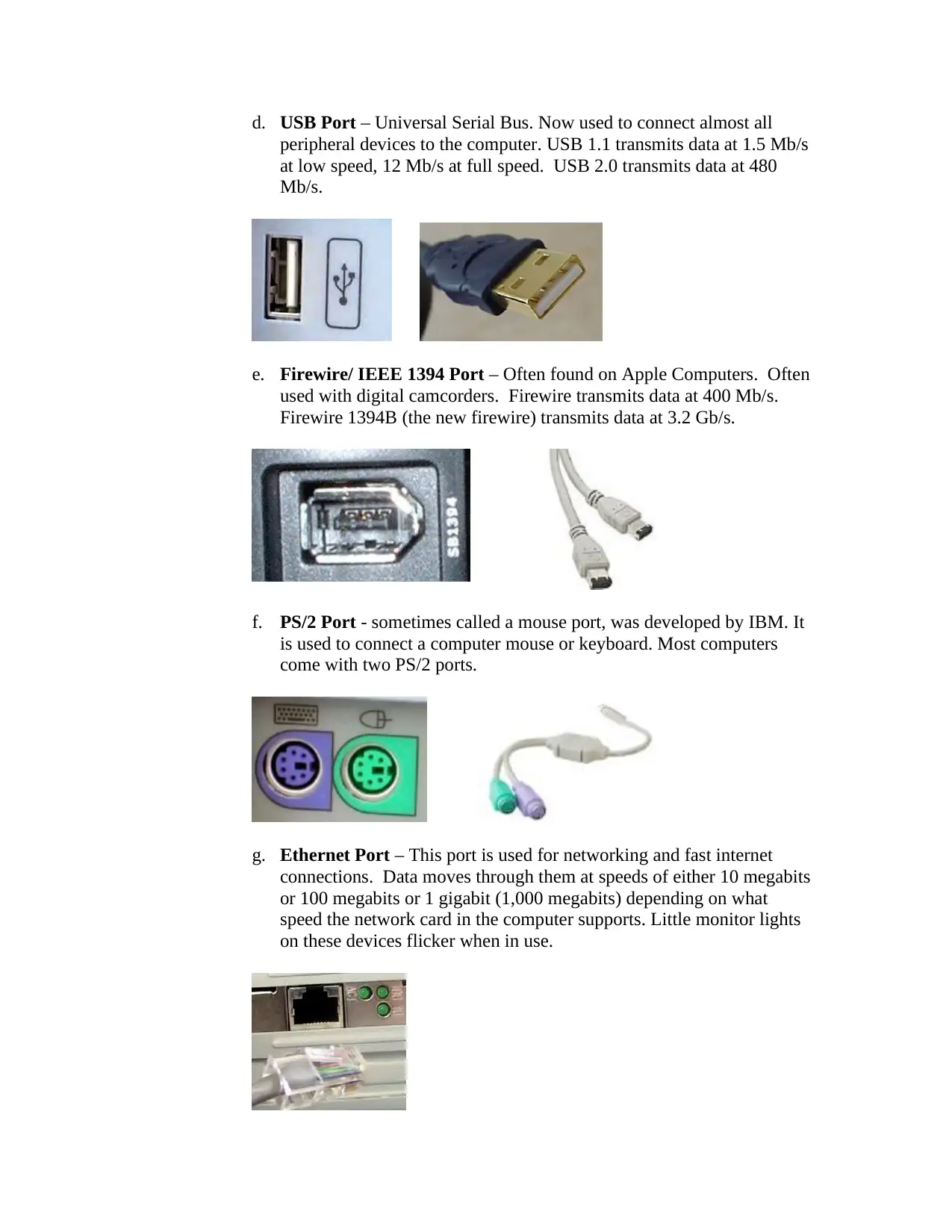
d. USB Port – Universal Serial Bus. Now used to connect almost all
peripheral devices to the computer. USB 1.1 transmits data at 1.5 Mb/s
at low speed, 12 Mb/s at full speed. USB 2.0 transmits data at 480
Mb/s.
e. Firewire/ IEEE 1394 Port – Often found on Apple Computers. Often
used with digital camcorders. Firewire transmits data at 400 Mb/s.
Firewire 1394B (the new firewire) transmits data at 3.2 Gb/s.
f. PS/2 Port - sometimes called a mouse port, was developed by IBM. It
is used to connect a computer mouse or keyboard. Most computers
come with two PS/2 ports.
g. Ethernet Port – This port is used for networking and fast internet
connections. Data moves through them at speeds of either 10 megabits
or 100 megabits or 1 gigabit (1,000 megabits) depending on what
speed the network card in the computer supports. Little monitor lights
on these devices flicker when in use.
peripheral devices to the computer. USB 1.1 transmits data at 1.5 Mb/s
at low speed, 12 Mb/s at full speed. USB 2.0 transmits data at 480
Mb/s.
e. Firewire/ IEEE 1394 Port – Often found on Apple Computers. Often
used with digital camcorders. Firewire transmits data at 400 Mb/s.
Firewire 1394B (the new firewire) transmits data at 3.2 Gb/s.
f. PS/2 Port - sometimes called a mouse port, was developed by IBM. It
is used to connect a computer mouse or keyboard. Most computers
come with two PS/2 ports.
g. Ethernet Port – This port is used for networking and fast internet
connections. Data moves through them at speeds of either 10 megabits
or 100 megabits or 1 gigabit (1,000 megabits) depending on what
speed the network card in the computer supports. Little monitor lights
on these devices flicker when in use.
Paraphrase This Document
Need a fresh take? Get an instant paraphrase of this document with our AI Paraphraser
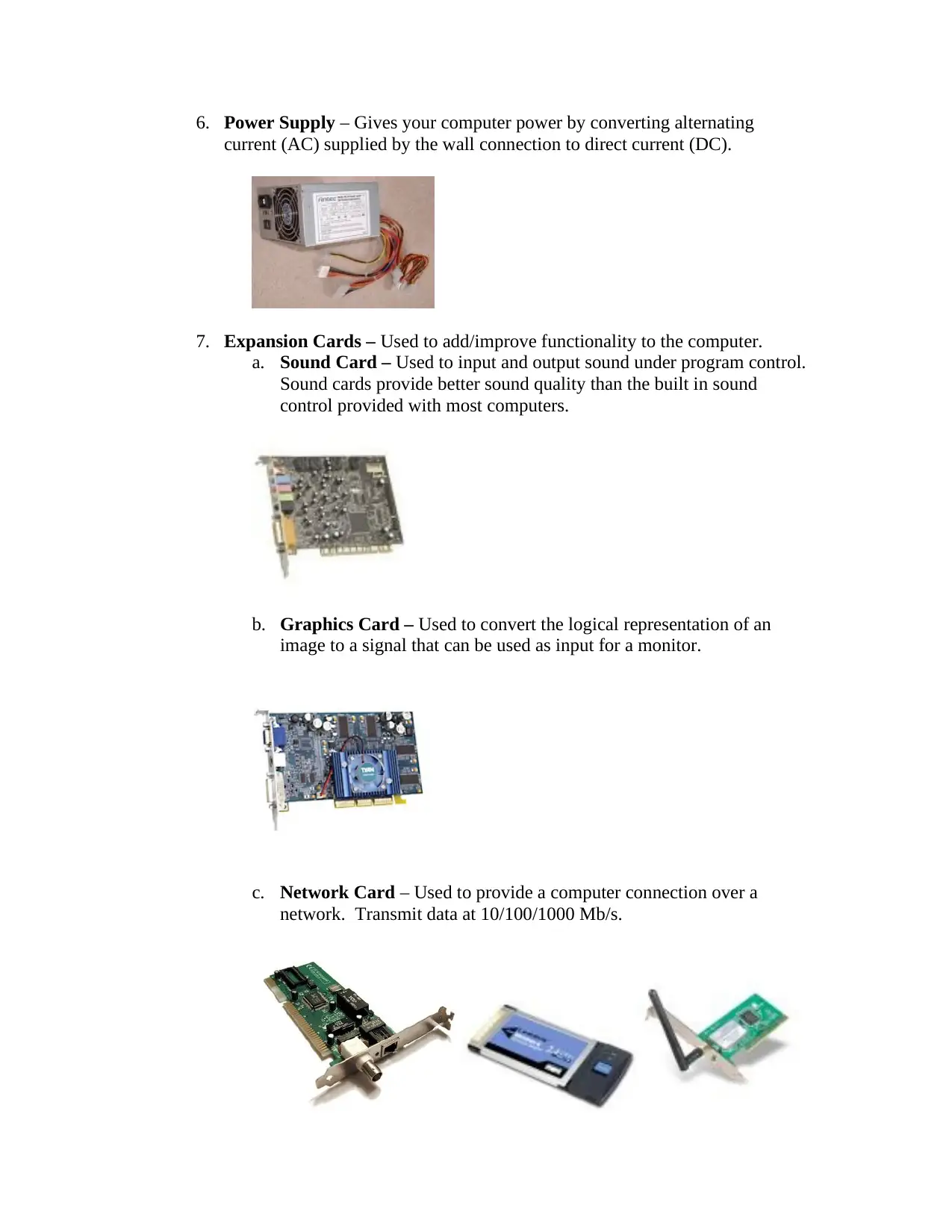
6. Power Supply – Gives your computer power by converting alternating
current (AC) supplied by the wall connection to direct current (DC).
7. Expansion Cards – Used to add/improve functionality to the computer.
a. Sound Card – Used to input and output sound under program control.
Sound cards provide better sound quality than the built in sound
control provided with most computers.
b. Graphics Card – Used to convert the logical representation of an
image to a signal that can be used as input for a monitor.
c. Network Card – Used to provide a computer connection over a
network. Transmit data at 10/100/1000 Mb/s.
current (AC) supplied by the wall connection to direct current (DC).
7. Expansion Cards – Used to add/improve functionality to the computer.
a. Sound Card – Used to input and output sound under program control.
Sound cards provide better sound quality than the built in sound
control provided with most computers.
b. Graphics Card – Used to convert the logical representation of an
image to a signal that can be used as input for a monitor.
c. Network Card – Used to provide a computer connection over a
network. Transmit data at 10/100/1000 Mb/s.
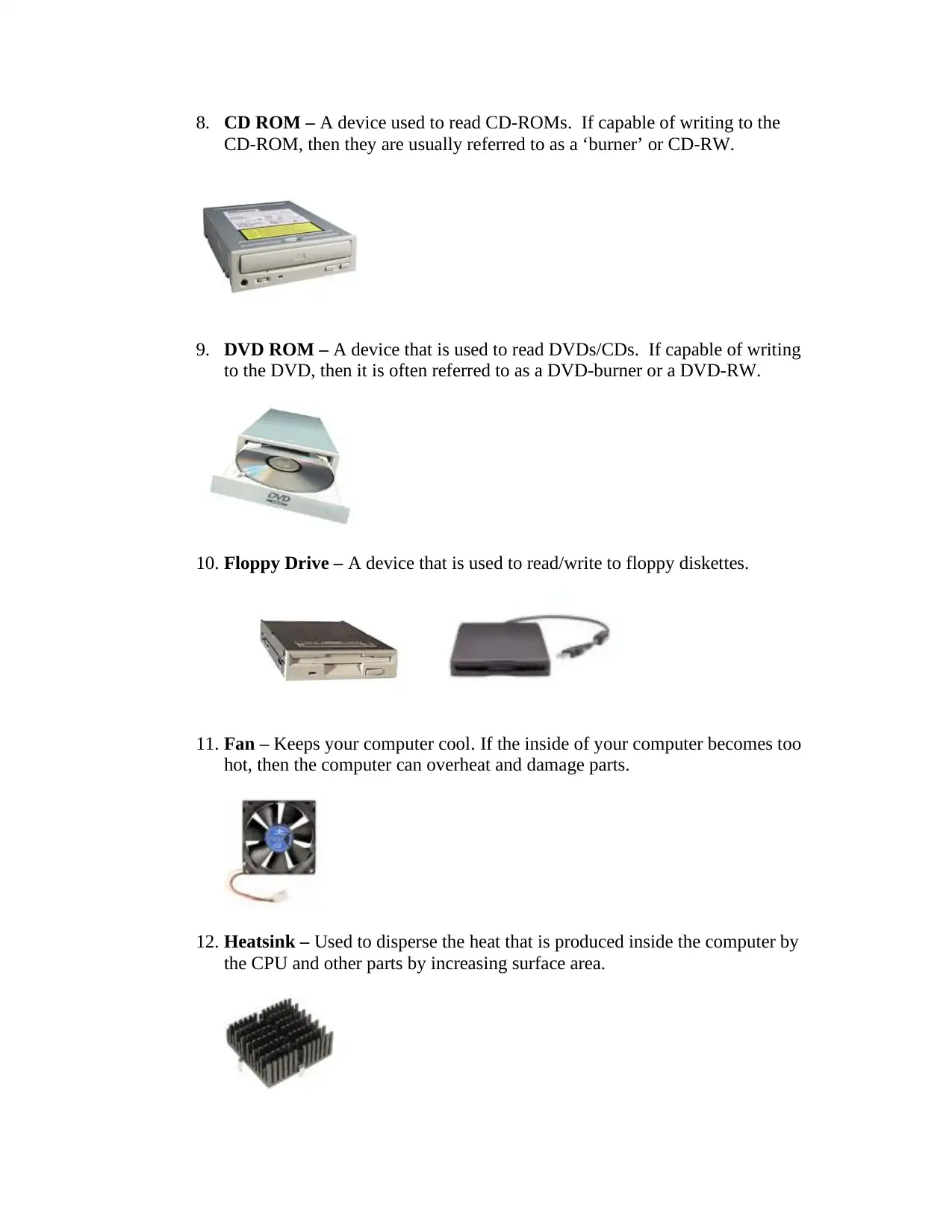
8. CD ROM – A device used to read CD-ROMs. If capable of writing to the
CD-ROM, then they are usually referred to as a ‘burner’ or CD-RW.
9. DVD ROM – A device that is used to read DVDs/CDs. If capable of writing
to the DVD, then it is often referred to as a DVD-burner or a DVD-RW.
10. Floppy Drive – A device that is used to read/write to floppy diskettes.
11. Fan – Keeps your computer cool. If the inside of your computer becomes too
hot, then the computer can overheat and damage parts.
12. Heatsink – Used to disperse the heat that is produced inside the computer by
the CPU and other parts by increasing surface area.
CD-ROM, then they are usually referred to as a ‘burner’ or CD-RW.
9. DVD ROM – A device that is used to read DVDs/CDs. If capable of writing
to the DVD, then it is often referred to as a DVD-burner or a DVD-RW.
10. Floppy Drive – A device that is used to read/write to floppy diskettes.
11. Fan – Keeps your computer cool. If the inside of your computer becomes too
hot, then the computer can overheat and damage parts.
12. Heatsink – Used to disperse the heat that is produced inside the computer by
the CPU and other parts by increasing surface area.
⊘ This is a preview!⊘
Do you want full access?
Subscribe today to unlock all pages.

Trusted by 1+ million students worldwide

13. The little parts – Capacitors – store energy, Resistors – allows a current
through, Transistors – a valve which allows currents to be turned on or off.
14. Case – (Tower if standing upright.) What your motherboard, CPU, etc is
contained in.
The three main components of a computer:
1. CPU – Central Processing Unit, coordinates all actions that occur in the system,
executes program instructions.
2. Memory – Used to store information.
3. I/O Devices – Input/Output devices, which allow you to obtain or display data.
Comprehension Questions:
1. What are the 3 main components of a computer?
2. Name 3 input devices. Name 3 output devices.
3. What is the brain of the computer?
4. Explain the difference between memory and your hard drive.
5. What are the similarities and differences between RAM, ROM, and hard drives?
6. What allows the brain of the computer to interact with the other parts of the
computer?
7. Describe each of the different ports and explain what they are used for.
8. What gives your computer power?
through, Transistors – a valve which allows currents to be turned on or off.
14. Case – (Tower if standing upright.) What your motherboard, CPU, etc is
contained in.
The three main components of a computer:
1. CPU – Central Processing Unit, coordinates all actions that occur in the system,
executes program instructions.
2. Memory – Used to store information.
3. I/O Devices – Input/Output devices, which allow you to obtain or display data.
Comprehension Questions:
1. What are the 3 main components of a computer?
2. Name 3 input devices. Name 3 output devices.
3. What is the brain of the computer?
4. Explain the difference between memory and your hard drive.
5. What are the similarities and differences between RAM, ROM, and hard drives?
6. What allows the brain of the computer to interact with the other parts of the
computer?
7. Describe each of the different ports and explain what they are used for.
8. What gives your computer power?
1 out of 7
Your All-in-One AI-Powered Toolkit for Academic Success.
+13062052269
info@desklib.com
Available 24*7 on WhatsApp / Email
![[object Object]](/_next/static/media/star-bottom.7253800d.svg)
Unlock your academic potential
Copyright © 2020–2025 A2Z Services. All Rights Reserved. Developed and managed by ZUCOL.


